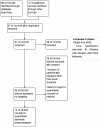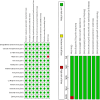A comparative analysis of hematopoietic stem cell transplantation in pediatric and adult patients: a systematic review and meta-analysis
- PMID: 40538430
- PMCID: PMC12176822
- DOI: 10.3389/frtra.2025.1551820
A comparative analysis of hematopoietic stem cell transplantation in pediatric and adult patients: a systematic review and meta-analysis
Abstract
Introduction: Hematopoietic stem cell transplantation (HSCT) is a significant treatment option for acute myeloid leukemia (AML). However, some important questions remain related to its efficacy and safety, specifically when administered to various age cohorts among pediatric and adult patients.
Aim: This study aimed to investigate the efficacy of HSCT in treating pediatric patients compared to adult patients diagnosed with AML.
Methods: A systematic search was conducted in PubMed, Scopus, Google Scholar, and Medline for studies published in the English language from inception to 2023. The findings were reported using the PRISMA checklist. Statistical analysis was conducted using Cochrane's software (Rev Man) version 5.4, which used random and fixed effect models when necessary.
Results: In total, 14 studies met the criteria for meta-analysis. The results indicated a slightly positive trend in overall survival in the pediatric and combined pediatric-adult groups compared to adults alone, although the differences were not statistically significant. For relapse rate, no significant differences were observed in the adult and pediatric groups individually, while the combined pediatric-adult group showed a substantial benefit from HSCT (OR: 2.3, P-value: -0.05). A similar trend was observed in disease-free survival, where the combined group showed a modest, though not statistically significant, improvement with HSCT. Furthermore, regarding treatment-related mortality, a statistically protective effect of HSCT was observed in the adult group (OR: 0.26, P = 0.0005), while the pediatric and combined groups did not show significant effects. For graft-vs.-host disease, a significant association with HSCT was found in the pediatric group (OR: 2.58, P = 0.03), while the adult and combined groups showed no significant effects.
Conclusion: Our analysis showed mixed results, showing a slightly better effect of HSCT in treating pediatric patients diagnosed with AML compared to adult patients.
Keywords: acute myeloid leukemia; confidence interval; disease free survival; odd ratio; overall survival; relapse rate; treatment related mortality.
© 2025 Maurya, Sagar, Chaturvedi, Pandey, Kushwaha and Kashyap.
Conflict of interest statement
The authors declare that the research was conducted in the absence of any commercial or financial relationships that could be construed as a potential conflict of interest.
Figures









Similar articles
-
Stem cell transplantation for systemic sclerosis.Cochrane Database Syst Rev. 2022 Jul 29;7(7):CD011819. doi: 10.1002/14651858.CD011819.pub2. Cochrane Database Syst Rev. 2022. PMID: 35904231 Free PMC article.
-
Systemic pharmacological treatments for chronic plaque psoriasis: a network meta-analysis.Cochrane Database Syst Rev. 2021 Apr 19;4(4):CD011535. doi: 10.1002/14651858.CD011535.pub4. Cochrane Database Syst Rev. 2021. Update in: Cochrane Database Syst Rev. 2022 May 23;5:CD011535. doi: 10.1002/14651858.CD011535.pub5. PMID: 33871055 Free PMC article. Updated.
-
Eliciting adverse effects data from participants in clinical trials.Cochrane Database Syst Rev. 2018 Jan 16;1(1):MR000039. doi: 10.1002/14651858.MR000039.pub2. Cochrane Database Syst Rev. 2018. PMID: 29372930 Free PMC article.
-
Selegiline for Alzheimer's disease.Cochrane Database Syst Rev. 2003;(1):CD000442. doi: 10.1002/14651858.CD000442. Cochrane Database Syst Rev. 2003. PMID: 12535396
-
Oral naltrexone as a treatment for relapse prevention in formerly opioid-dependent drug users: a systematic review and economic evaluation.Health Technol Assess. 2007 Feb;11(6):iii-iv, 1-85. doi: 10.3310/hta11060. Health Technol Assess. 2007. PMID: 17280624
References
-
- Battipaglia G, Boumendil A, Labopin M, Ciceri F, Tischer J, Stelljes M, et al. Unmanipulated haploidentical versus HLA-matched sibling allogeneic hematopoietic stem cell transplantation in relapsed/refractory acute myeloid leukemia: a retrospective study on behalf of the ALWP of the EBMT. Bone Marrow Transplant. (2019) 54:1499–510. 10.1038/s41409-019-0459-7 - DOI - PubMed
-
- Montoro J, Ceberio I, Hilden P, Maloy MA, Barker J, Castro-Malaspina H, et al. Ex vivo T cell-depleted hematopoietic stem cell transplantation for adult patients with acute myelogenous leukemia in first and second remission: long- term disease-free survival with a significantly reduced risk of graft-versus-host disease. Biol Blood Marrow Transplant. (2020) 26:323–32. 10.1016/j.bbmt.2019.10.003 - DOI - PMC - PubMed
Publication types
LinkOut - more resources
Full Text Sources
Miscellaneous

